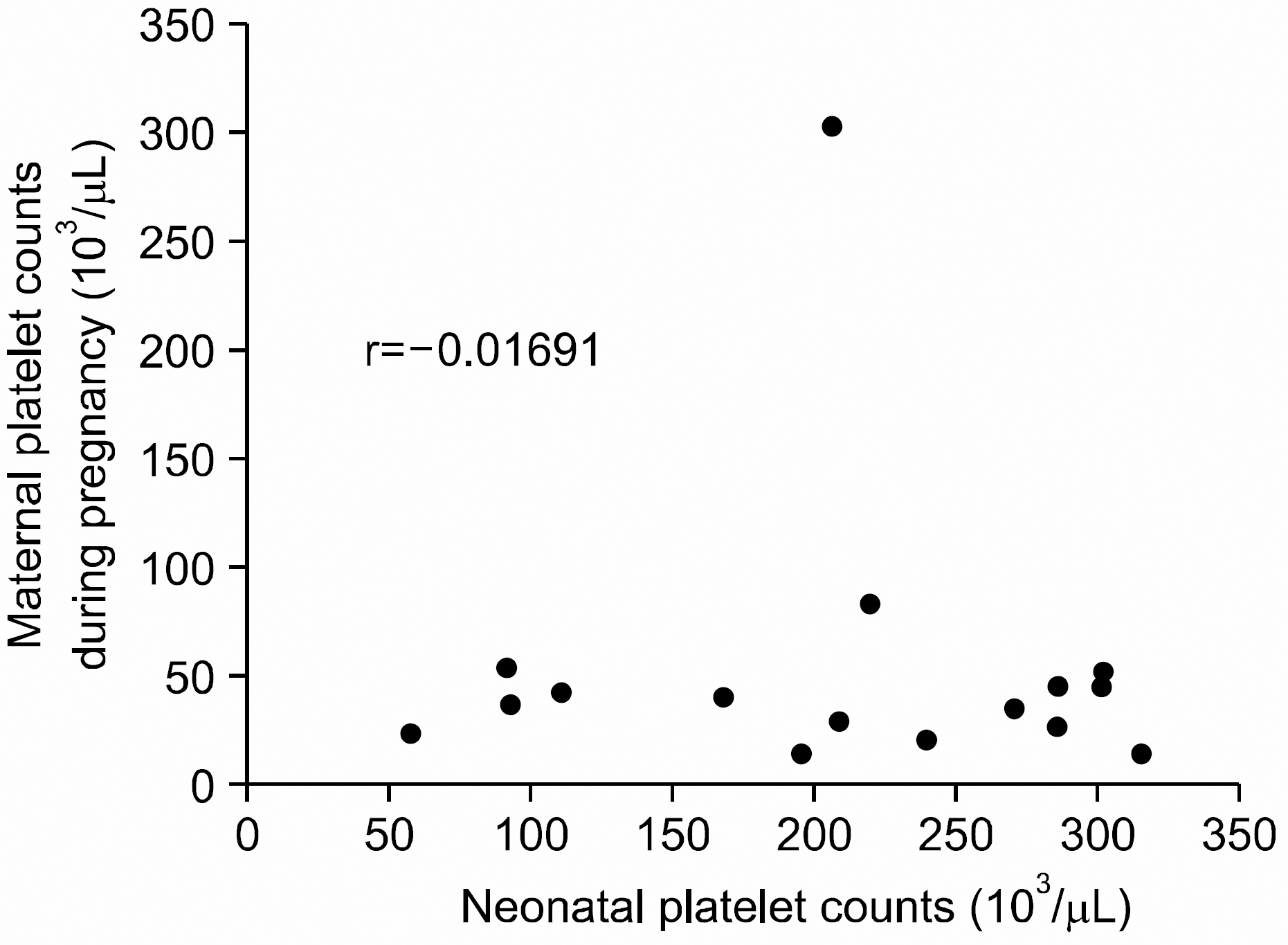Abstract
Background:
Patients with the condition of idiopathic thrombocytopenic purpura (ITP) may present with, maternal and fetal hemorrhagic complications. Appropriate monitoring and treatment may be important in obstetric management.
Methods:
A retrospective chart review was performed for obstetric patients with ITP at Bundang CHA hospital from March 1996 to March 2005.
Results:
Nineteen women with ITP delivered 22 children in 22 pregnancies. The median age at delivery was 30 years (range, 21~37 years). The median platelet counts before pregnancy, during pregnancy, and at delivery were 44,000/μL (range, 20,000~225,000/μL), 40,500/μL (range, 13,000~335,000/μL), and 73,500/μL (range, 40,000~308,000/μL. Treatment for ITP was done in 14 cases (63.6%) during pregnancy and in 18 cases (81.8%) at delivery. Platelet transfusion was done for one case during pregnancy but, was performed in 17 cases (77.3%) at delivery. Vaginal delivery was done in 10 cases (45%) and a Cesarean section was done in 12 cases (55%). No obstetric complications were observed. The median platelet count of 17 infants was 220,000/μL (range, 59,000~315,000/μL). Four neonates were born with platelet counts below 150,000/μL. No infant showed any clinical signs of hemorrhage and there were not any neonatal complications.
Conclusion:
In our study, obstetric patients with ITP and their neonates were safe with no hemorrhagic complication. However, when compared to the current guidelines, the treatment strategy used in the present study was excessive. Appropriate treatment according to the guidelines is necessary during the obstetric management of patients with ITP.
Go to : 
REFERENCES
1.Fujimura K., Harada Y., Fujimoto T, et al. Nationwide study of idiopathic thrombocytopenic purpura in pregnant women and the clinical influence on neonates. Int J Hematol. 2002. 75:426–33.

2.Hohlfeld P., Forestier F., Kaplan C., Tissot JD., Daffos F. Fetal thrombocytopenia: a retrospective survey of 5,194 fetal blood samplings. Blood. 1994. 84:1851–6.

3.Dan U., Barkai G., David B., Goldenberg M., Kukkia E., Mashiach S. Management of labor in patients with idiopathic thrombocytopenic purpura. Gynecol Obstet Invest. 1989. 27:193–6.

5.Burrows RF., Kelton JG. Low fetal risks in pregnancies associated with idiopathic thrombocytopenic purpura. Am J Obstet Gynecol. 1990. 163:1147–50.

6.Burrows RF., Kelton JG. Pregnancy in patients with idiopathic thrombocytopenic purpura: assessing the risks for the infant at delivery. Obstet Gynecol Surv. 1993. 48:781–8.
7.Letsky EA., Greaves M. Guidelines on the investigation and management of thrombocytopenia in pregnancy and neonatal alloimmune thrombocytopenia. Maternal and Neonatal Haemostasis Working Party of the Haemostasis and Thrombosis Task Force of the British Society for Haematology. Br J Haematol. 1996. 95:21–6.
8.George JN., Woolf SH., Raskob GE, et al. Idiopathic thrombocytopenic purpura: a practice guideline developed by explicit methods for the American Society of Hematology. Blood. 1996. 88:3–40.
9.Hahn JS., Roh HK., Son SH., Lee SJ., Ko YW. The therapeutic consideration in idiopathic thrombocytopenic purpura with pregnancy. Korean J Hematol. 1989. 24:323–33.
10.Lee SG., Lee JH., Jun JK., Yoon BH., Syn HC., Kim SW. Clinical features of idiopathic thrombocytopenic purpura in pregnancy. Korean J Obstet Gynecol. 1994. 37:1922–9.
11.Chung EJ., Park JC., Rhee JH., Kim JI. The clinical features of idiopathic thrombocytopenic purpura in pregnancy and prediction of neonatal thrombocytopenia. Korean J Obstet. 2004. 47:605–11.
12.Webert KE., Mittal R., Sigouin C., Heddle NM., Kelton JG. A retrospective 11-year analysis of obstetric patients with idiopathic thrombocytopenic purpura. Blood. 2003. 102:4306–11.

13.Kimura S., Kuroda J., Akaogi T, et al. Treatment of steroid-resistant idiopathic thrombocytopenic purpura in pregnancy with repeated high-dose intravenous immunoglobulin. Haematologia. 2001. 31:263–5.

14.Territo M., Finklestein J., Oh W., Hobel C., Kattlove H. Management of autoimmune thrombocytopenia in pregnancy and in the neonate. Obstet Gynecol. 1973. 41:579–84.
Go to : 
 | Fig. 1Relationship between the maternal platelet count during pregnancy and neonatal platelet count. |
Table 1.
Clinical characteristics of patients
Table 2.
Platelet count before pregnancy, during preg nancy, and at delivery
| Time | Number of patient | Platelet count median (range) |
|---|---|---|
| Before pregnancy | 9 | 44,000 (20,000~225,000)/μL |
| During pregnancy | 20 | 40,500 (13,000~335,000)/μL |
| At delivery | 22 | 73,500 (40,000~308,000)/μL |
Table 3.
Treatment option of obstetric patients with ITP




 PDF
PDF ePub
ePub Citation
Citation Print
Print


 XML Download
XML Download